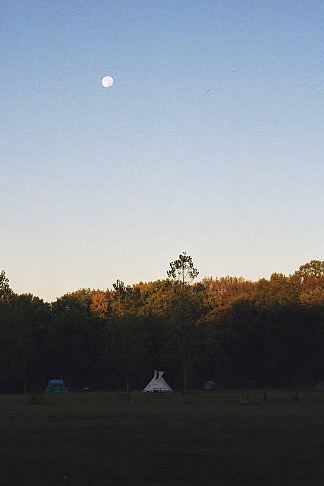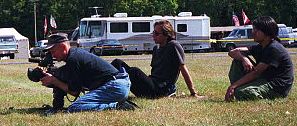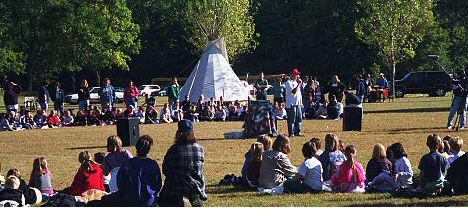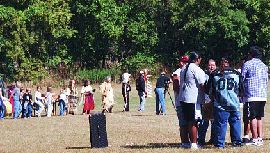|
|
How to Hold a Native American Cultural Education Day
By Solomon-Grade 8
 INTRODUCTION
AND BACKGROUND:
INTRODUCTION
AND BACKGROUND:
Every year for the past 14 years, a Native American Education Day has been held on the Friday before the annual
Mahkato powwow that is held in Mankato, Minnesota, on the third full weekend of September. The Education Day offers
third graders in the Mankato school district a brief glimpse into a different culture.
On that day, children from most of the schools in the district get together on a field in the Land of Memories
Memorial Park. The annual powwow is held in recognition of the 38 plus two Dakota warriors who were hung at Mankato
after the Dakota conflict of 1862. The year 1987 was declared the Year of Reconciliation between the Native and
non-Native communities since the Conflict. During that year, Native American author Vine Deloria, Jr., issued a
challenge to create “new ceremonies” or reconciliation events which would include Native and non-Native people
and the land and that would be held as a continuing tradition, not just a single event.
Mankato residents Sheryl and Bruce Dowlin were inspired by Mr. Deloria’s challenge and approached Bob Nelson, the
curriculum director of the Mankato school district. He suggested they design some kind of education program that
would tie into the annual powwow. Sheryl and Bruce took this suggestion to Dakota spiritual leaders Amos and Ione
Owen, now deceased, and asked them what they thought.
The Owen’s supported the idea fully and offered suggestions for 12 resource people from the Native Community. Tom
Goldtooth, a Diné (Navajo), was arena director for the powwow that year and he helped to contact the presenters
suggested by Amos and Ione Owen, and offered a suggestion that the students be gathered in a traditional circle
for introduction before the presentations and for a friendship dance after their learning experience. The education
day was added on the Friday before the powwow that fall.
When the children arrive at the park, thirty-two Native Culture teachers are arranged in a circle of approximately
150 feet radius. There is a presentation in a large center circle where there is an introduction and a prayer ceremony
and the activity is explained. After that, small groups are assigned to individual learning stations. After each
learning session, a signal is sounded and the groups rotate to the next learning station. Each group of students
has time to visit four to five learning presentations of about 12 minutes each.
Planning for this day is a year round process, which includes planning with community elders and representatives,
arranging for presenters, scheduling the field trip from the schools, budgeting, grant-writing, organizing, arranging
for publicity, planning for meals for presenters, and arranging for clean-up and follow-up.
One of the best aspects of this kind of cultural presentation day is that it can potentially be adapted for use
to teach almost any other culture and would be ideally suited to many school's and/or community's philosophy and
curriculum. However, for the purposes of this report, I will be referring to it as a Native American Education
Day.
 In order to make this report I spoke with, Dr. Sheryl and Bruce Dowlin of Mankato, MN; Paul Barry
and Vicki Lockard, current organizers of the Mankato Education Day and web masters of the web site Canku Ota; Mike
Ballard, Eastern Cherokee; Jerry Dearly, Lakota; Dr. Ned Reese, University of Wisconsin, Lacrosse; and Dr. Wayne
Allen, Ethnic Studies Department, University of Mankato. I have had the opportunity to attend this event and the
weekend powwow every year of my life. This year I also had the opportunity of working with Kristian Berg, the videographer
who made the KTCA/PBS production of “Dakota Conflict, Dakota Exile,” as he and his crew filmed the Education Day
events.
In order to make this report I spoke with, Dr. Sheryl and Bruce Dowlin of Mankato, MN; Paul Barry
and Vicki Lockard, current organizers of the Mankato Education Day and web masters of the web site Canku Ota; Mike
Ballard, Eastern Cherokee; Jerry Dearly, Lakota; Dr. Ned Reese, University of Wisconsin, Lacrosse; and Dr. Wayne
Allen, Ethnic Studies Department, University of Mankato. I have had the opportunity to attend this event and the
weekend powwow every year of my life. This year I also had the opportunity of working with Kristian Berg, the videographer
who made the KTCA/PBS production of “Dakota Conflict, Dakota Exile,” as he and his crew filmed the Education Day
events.
ORGANIZING A CULTURAL EDUCATION DAY:
The first and most important thing to remember when planning a Cultural Educational Program is to begin by consulting
the elders and advisors of the cultural group you plan to present. When at all possible, the teachers and presenters
should be respected and knowledgeable members of the cultural community. This will assure the elders and the cultural
community that their culture is not being taken away from them and will be presented to the outside community respectfully
and accurately.
You have to have the support of the community. If they believe that they are going to be able to present their
culture the right way, the support will follow. According to Vicki Lockard organizer and editor of the web site
Canku Ota, “We have found that Native people will do just about anything for children -- but you have to ask. The
Elders have no problem with the white community learning, as long as you ask respectfully and really want to learn.”
Ned Reese of the University of Wisconsin, LaCrosse, says that they talked to the local Ho-Chunk elders in their
community when they set up their powwow and education day. One of the Ho-Chunk elders suggested to them that they
refer to the powwow and activities as a “cultural exchange,” to make sure that people will be comfortable with
it. They decided together to “use the term inter-cultural relations rather than multi-cultural because it implies
an interaction and a mutual respect.”
The next most important thing to remember, according to Sheryl Dowlin, is to get the approval of the school or
organization that is going to participate. Every group has to be involved, so that teachers and presenters and
the community that is going to be presented have a good understanding of what you are trying to accomplish. It
is important that everyone involved has some input but the cultural community should have the strongest voice.
 It is important for you to provide resource materials to the schools and teachers before the Education
Day event. These materials can include short explanations of topics that will be taught, a brief cultural background
of things like traditional dances, and ways to show respect to the people of the culture that the students will
be meeting, like shaking the hands of the presenters, etc.
It is important for you to provide resource materials to the schools and teachers before the Education
Day event. These materials can include short explanations of topics that will be taught, a brief cultural background
of things like traditional dances, and ways to show respect to the people of the culture that the students will
be meeting, like shaking the hands of the presenters, etc.
“The kids, and some adults, are kind of afraid when meeting people from a culture that is unknown to them,” says
Cherokee Mike Ballard. “Gaining the respect of teachers is the key. If the teachers have respect for a presenter
then, the kids will too.” He says to “remember that there will always be some detractors or people who try to make
trouble for you, but keep your eye on the eagle, on your goal. Stay focused. Don't lose sight of your purpose.”
PLANNING
“Don’t Panic,” is the first rule in organizing an event like this, said Paul Barry, this year's Mankato Education
Day co-coordinator. This means that if something goes wrong, don't worry too much about it, like if some presenters
do not show up or if the teachers didn't get the day's schedule before they came to the park. Mike Ballard also
advised that we “follow the old maxim of ‘Keep it simple -- Make it fun. Fun for both the kids and the presenters.”
“If you invite a bunch of people, presenters,” said Paul, “somebody is not going to show up.” In Mankato you will
find a lot of people to present and fill in for an emergency, but that won't be true in a school event. Every year
about ten percent of the presenters don't show up because of car trouble, family emergencies, etc. It is a good
idea to overbook presenters. If you are giving an honorarium, you should make sure they understand that you are
overbooking for emergencies but that even if there is not enough room for all the presenters who show up, everyone
who does show up will receive the honorarium anyway.
 To find presenters you can ask people you already
know, ask the elders and ask people of the arts community of the culture
to recommend certain people who would be a good resource. Then you have
to develop a trust with the possible presenters. They will be more likely
to say yes if they know that you respect them and don't just want to take
advantage of their knowledge. In the Native American community it can
take a whole year of developing friendships and trust with the presenters
you want to work with you. If you want to contact presenters from a culture
you should go to social gatherings of theirs.
To find presenters you can ask people you already
know, ask the elders and ask people of the arts community of the culture
to recommend certain people who would be a good resource. Then you have
to develop a trust with the possible presenters. They will be more likely
to say yes if they know that you respect them and don't just want to take
advantage of their knowledge. In the Native American community it can
take a whole year of developing friendships and trust with the presenters
you want to work with you. If you want to contact presenters from a culture
you should go to social gatherings of theirs.
SCHEDULING WITH THE SCHOOL DISTRICT
After you have chosen the day the event will be held, you should start talking to the school district so that they
can decide on scheduling when and how the kids get there. You should be aware of and try to accommodate the needs
of the school district, the teachers and the kids. You have to let the teachers know things like that the kids
will be in smaller groups so they can prepare to have enough adults to supervise them.
BUDGETING
You should get grants to cover the expenses of the Education Day and money from the school district so that you
can pay for things like honorariums and supplies. When you make a budget, you have to plan for honorariums for
the presenters, letters and postage for contacting the schools and the presenters, supplies for setting up the
stations, and miscellaneous emergency supplies. Another thing you have to budget for is food and coffee and water
for the presenters. In most cultures food is usually something that is shared to show respect for each other. You
should always ask a person from that culture to do the cooking and to ask them what supplies they will need. You
also have to pay for parking for the presenters.
PLANNING FOR THE DAY
A lot of the planning for the event needs to be done ahead of time. For the Mankato Education Day in September,
letters are first sent out to the chosen presenters in June. If you are going to do this for the first time, you
might want to start making those contacts even earlier.
Over the summer the Mankato organizers make contacts with previous and new presenters at cultural events like powwows.
In late August, letters or contracts of confirmation and parking permits are sent out.
Then you have to plan for using the space you are going to teach in. For example, you have to do the math for how
big your circle or space is going to be. Spacing stations thirty feet apart works well except for teepees, drums
or other large activated such as games, which might need more space. For a circle of 32 presenters you need a circle
of about 150 foot radius.
You need to plan for volunteer people to help the cook, run errands for the presenters and for setting up and cleaning
up before and after the presentations.
Some things you don’t plan on are going to happen. Some of the presenters won’t show up, or two people will show
up to teach the same thing. You have to be ready to change your layout. You have to be flexible in your schedule,
it is not always a definite thing that is going to happen. Sometimes you have to change who is presenting where
or spread out the layout at the last minute. “The behind the scenes work really makes the difference,” Sheryl Dowlin
advised.
THE DAY
On the day of the event, the kids will arrive and get into the center circle where they are given an introduction
by an organizer and an elder. In Mankato a brief prayer ceremony is performed by a Native Spiritual Adviser or
elder. Because this prayer could cause a problem in some schools, Jerry Dearly, a respected Lakota and teacher
suggested that the actual prayer is not necessary. The important thing is to show respect for the culture.
All of the kids divide into smaller groups and each group goes to an assigned learning station, one small group
for every station, for a 12 to 15 minute presentation. When the signal is sounded, the groups each rotate to the
next learning station. After four or five session, depending on your schedule, the kids return to the center circle
for a concluding talk and then they do a  friendship dance out to their buses. Keep
in mind that the dance makes a good diversion to get the students to their buses.
friendship dance out to their buses. Keep
in mind that the dance makes a good diversion to get the students to their buses.
Be sure to keep a box of emergency supplies handy. It is also a good idea to take pictures or videos to record
the event. It is important to do follow-up after the Education Day. You should get feedback about how the day went
and suggestions for the next year, from teachers, the children and the presenters. After you get the feedback,
it is really a good idea to give this feedback to the elders and community members who helped you get the program
organized and started. You can also include the feedback when applying for grants for future Education Days.
WRITING THE PROPOSAL
When you are writing the proposal for an Education day you need to include the purpose you have for holding the
event, a list of presenters you plan to use, information on how much you expect it to cost, how you will set up
and organize the day itself, like meals, the setting, how it works, how you will let people and the community know
about the event, and how you will do clean-up and follow-up.
CONCLUSION
In the first year of this Education day in Mankato, there were only 12 presenters and there was no money for an
honorarium. This year, we had 32 to 34 presenters, a $75 honorarium, and a budget of $4500. Over the past years
the idea of holding an event like this has spread. In Kansas, a similar program was begun eight years ago. They
basically do the same thing, but they have 30 presenters and offer a $50 honorarium and have a $2500 total budget.
They used to hold it all day, but the heat was a problem, especially with the attention span of the kids, so now
they have a morning schedule only. Another program is held in LaCrosse, Wisconsin, in conjunction with the University
student powwow. They offer the program to fourth graders for a whole day, and have a budget of about $2500. I think
it would be a really good idea to hold one of these Education Days at our school.![]()
|
|
| Canku Ota is a free Newsletter celebrating Native America, its traditions and accomplishments . We do not provide subscriber or visitor names to anyone. Some articles presented in Canku Ota may contain copyright material. We have received appropriate permissions for republishing any articles. Material appearing here is distributed without profit or monetary gain to those who have expressed an interest. This is in accordance with Title 17 U.S.C. section 107. |
|
Canku Ota is a copyright of Vicki Lockard and Paul Barry. |
|